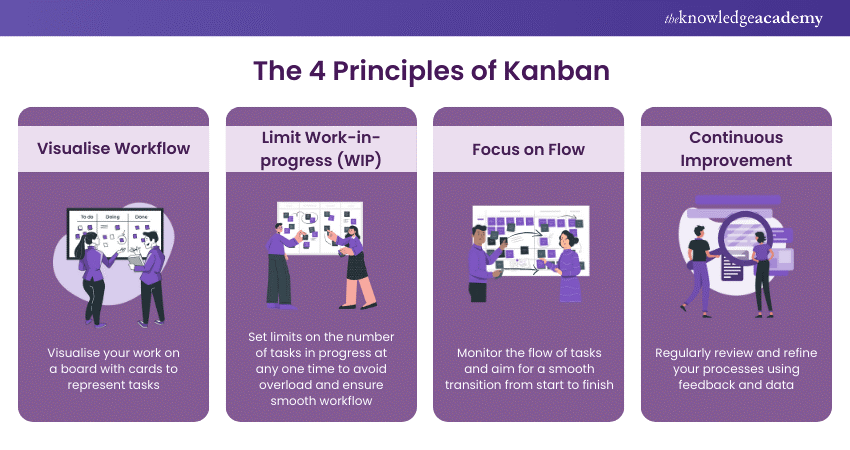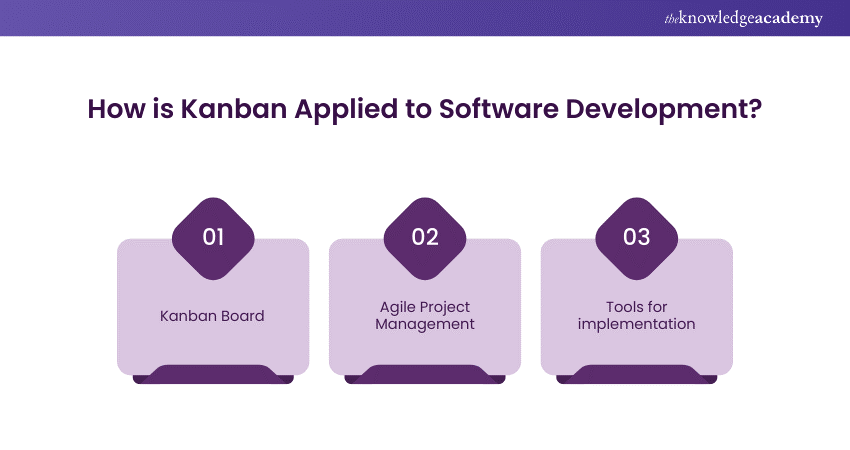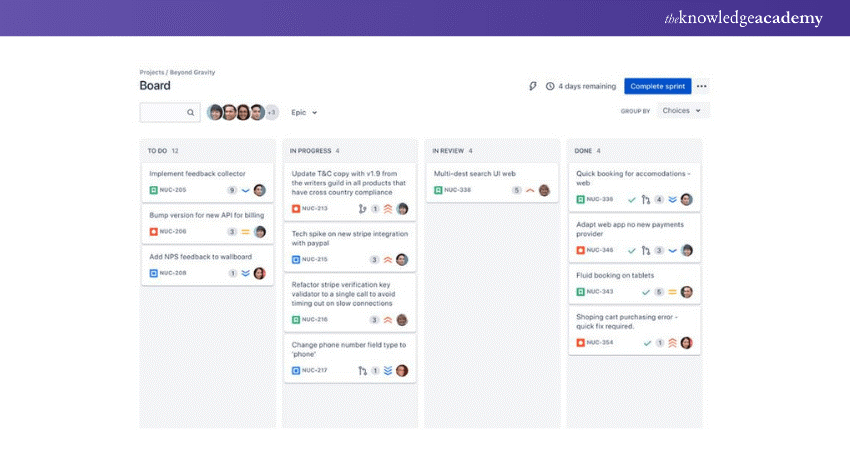We may not have the course you’re looking for. If you enquire or give us a call on +420 210012971 and speak to our training experts, we may still be able to help with your training requirements.
We ensure quality, budget-alignment, and timely delivery by our expert instructors.

Are you looking for a Project Management method that’s both simple and efficient? Maybe the one you are using currently is not easy to monitor and has blind spots to certain bottlenecks. This is where Kanban exceeds as an ideal project management tool. It is a widely used method that visualises projects with cards on a Kanban Board.
Many teams find this approach easy to use and highly effective in improving efficiency and output. It focuses on delivery and continuous improvement and ensures that your team remains productive and on schedule.
This blog on Kanban Principles will help you discover how it can revolutionise your workflow and make communication and collaboration among team members more efficient. Continue reading below to transform your Project Management approach!
Table of Contents
1) What is Kanban?
2) The Four Kanban Principles
3) How is Kanban applied to Software Development?
4) Are Kanban Principles easy to implement?
5) Conclusion
What is Kanban?
Kanban is a highly visual work management method developed by Toyota in Japan during the late 1940s, and it translates to "visual card" in Japanese. It is particularly valuable for managing projects that require frequent deliverables and is widely used by software development teams. By displaying cards on a board, teams can easily visualise their workflow.
This method allows for quick identification of disruptions, enabling team members to collaborate and address issues before they escalate. One of the commendable features in Kanban is its focus on limiting the amount of work-in-progress (WIP), which minimises the build-up of tasks and reduces wasted time and resources.
Unlike a push system where tasks are assigned regardless of capacity, Kanban employs a pull system. Team members only start new work when they have the capacity to prevent work from piling up.
Boost your Project Management skills with our Certified Kanban Practitioner Certification Course – join today!
The Four Kanban Principles
Here are the four Kanban Principles that would help you transform your Project Management approach.

1) Visualise workflow
Use a board to visualise your work with cards representing user stories in your product backlog. Colour-code these cards based on their themes. A simple Kanban board might have columns labelled "TO-DO" and "DONE," with additional columns in between to denote various stages or responsible individuals. Further, divide these columns into "Doing" and "Done." This setup allows the team to see work-in-progress, completed tasks, and upcoming tasks. Move cards from left to right as work progresses.
2) Limit Work-in-progress (WIP)
Set limits on how many tasks can be in progress in each column at any given time. This ensures a smooth flow of cards across the board as the team is ready for them. Prioritise the highest priority tasks in your "TO-DO" column from your product backlog using Kanban Flow. When space opens up in the "TO-DO" column, fill it with the next highest priority task.
Setting WIP limits helps quickly identify blockages, enabling the team to collaborate on solutions. This also eliminates multi-tasking, which hampers productivity.
3) Focus on flow
Ensure that work flows smoothly through the Kanban system with minimal interruptions. Monitor and analyse flow metrics to identify areas for improvement. Key metrics to track include:
1) Lead time: How long does it take for a card to move from "TO-DO" to "DONE."
2) Cycle time: How long does it take for a card to move from "Doing" to "Done." In understanding Cycle Time vs Lead Time, it's important to note that while lead time captures the full process from start to finish, cycle time only focuses on the active working period.
3) Number of items not started: Assesses workload management.
4) Number of WIP items: Ensures adherence to WIP limits.
5) Blockage areas: Identifies areas where cards build up, which contribute to flow interruptions.
4) Continuous improvement
Even after implementing Kanban, continuous improvement is essential. Regularly monitor and refine your processes using Kanban in OneNote to enhance efficiency and effectiveness.
Also learn about the difference between Kanban and Agile in Kanban vs Agile blog.
How is Kanban applied to Software Development?
Kanban methodology is developed to enhance manufacturing efficiency. It has been adapted for software development to optimise workflows and reduce inefficiencies. Kanban emphasises in task visualisation, limitation in work-in-progress and a smoother flow of tasks from start to finish. The various applications of Kanban in software development are mentioned below.

1) Kanban Board
A key component of Kanban is the Kanban board, a visual tool that assists teams in tracking task progress. This board serves as a single source of truth, enabling teams to see the status of tasks at a glance.
2) Agile Project Management
Kanban aligns well with Agile Project Management, the preferred approach for DevOps software development teams seeking flexibility and iterative progress. Agile methodology is developed to adapt to change and deliver small, incremental improvements, making it ideal for managing the constant changes inherent in software development.
3) Tools for implementation
Jira offers a ready-to-use Kanban board template that simplifies the process for software teams. This tool helps prioritize, visualize, and manage a continuous delivery of work, facilitating efficient project management. By integrating Kanban into software development, teams can enhance workflow efficiency, reduce waste, and better manage the delivery of projects, as outlined in the Kanban PDF, which provides a comprehensive guide on the process.
Prepare for your Kanban interview with these essential Kanban Interview Questions and Answers.
Are Kanban Principles easy to implement?
Now, let’s look into how easy and efficient Kamban Principles is to implement in your projects.
Ease of implementing Kanban Principles
Introducing Kanban Principles is designed to be simple and non-disruptive. These principles focus on making incremental changes and do not require a complete overhaul of existing processes. To implement Kanban, a team needs only a board and some cards to represent tasks. Virtual boards are particularly useful for remote teams, facilitating information sharing and streamlined communication. For those new to Kanban or looking to optimise their implementation, referring to a Kanban Cheat Sheet can provide valuable insights and tips for improving workflow management efficiently.
Tools for implementation
For software teams, Jira provides a robust set of Project Management tools that support Agile Methodologies, including Kanban. With Jira’s ready-to-use Kanban template, teams can easily set up their next project and begin moving work forward efficiently.

Jira also benefits business teams in areas such as marketing, HR, or finance by enabling them to apply Kanban Principles and oversee tasks across various projects and operations. In addition to Calendar and Timeline views, Jira offers a board view, providing a clear and intuitive way to visualise work.
Collaborative platform
Jira serves as a shared collaboration platform across an organisation, allowing software developers and their non-technical counterparts to stay connected. The platform is tailored to various use cases, enabling teams to connect projects, documents, and tasks. This integration streamlines collaboration and communication, breaks down silos, and helps prevent project delays.
Elevate your workflow with our Certified Kanban Foundation Course – join today!
Conclusion
Kanban is one of the easiest agile practices to implement in any organisation. It gives Project Managers a global view of tasks. This system encourages collaboration and is suitable for everything from software development to marketing. If your team follow the Four Kanban Principles and practices discussed in this blog, they can achieve success.
Learn Kanban process and its principles with our Certified Kanban Foundation and Practitioner Course – join today!
Frequently Asked Questions
Why is visualising workflow important in Kanban?

Visualising workflow in Kanban is crucial as it provides a clear visual representation of task progress. This visibility allows teams to quickly identify bottlenecks, manage workloads, and ensure smooth transitions between task stages, ultimately enhancing collaboration and efficiency.
What role does continuous improvement play in Kanban?

Continuous improvement in Kanban involves regularly reviewing and refining processes to enhance efficiency and productivity. By consistently analysing performance and incorporating feedback, teams can address issues, streamline workflows, and adapt to changing needs, ensuring long-term success and value delivery.
What are the other resources and offers provided by The Knowledge Academy?

The Knowledge Academy takes global learning to new heights, offering over 3,000 online courses across 490+ locations in 190+ countries. This expansive reach ensures accessibility and convenience for learners worldwide.
Alongside our diverse Online Course Catalogue, encompassing 19 major categories, we go the extra mile by providing a plethora of free educational Online Resources like News updates, Blogs, videos, webinars, and interview questions. Tailoring learning experiences further, professionals can maximise value with customisable Course Bundles of TKA.
What is the Knowledge Pass, and how does it work?

The Knowledge Academy’s Knowledge Pass, a prepaid voucher, adds another layer of flexibility, allowing course bookings over a 12-month period. Join us on a journey where education knows no bounds.
What are related courses and blogs provided by The Knowledge Academy?

The Knowledge Academy offers various Kanban Training, including the Certified Kanban Foundation and Practitioner Training, Certified Kanban Foundation Training, Certified Kanban Practitioner Training. These courses cater to different skill levels, providing comprehensive insights into Kanban Software.
Our Business Improvement Blogs cover a range of topics related to Kanban, offering valuable resources, best practices, and industry insights. Whether you are a beginner or looking to advance your Manufacturing Efficiency skills, The Knowledge Academy's diverse courses and informative blogs have got you covered.
Upcoming Business Improvement Resources Batches & Dates
Date
 Certified Kanban Foundation and Practitioner Training
Certified Kanban Foundation and Practitioner Training
Mon 4th Aug 2025
Mon 3rd Nov 2025






 Top Rated Course
Top Rated Course



 If you wish to make any changes to your course, please
If you wish to make any changes to your course, please


